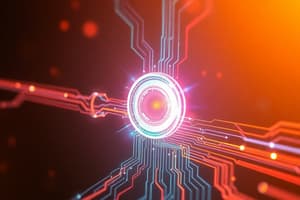Podcast
Questions and Answers
What effect does a 100% increase in 𝜷 have on the BJT collector current?
What effect does a 100% increase in 𝜷 have on the BJT collector current?
- It increases by 100%
- It increases by 81% (correct)
- It remains unchanged
- It decreases by 100%
Which bias configuration is more stable under variations of 𝜷?
Which bias configuration is more stable under variations of 𝜷?
- Voltage Divider Bias Configuration (correct)
- Fixed-bias configuration
- Emitter bias configuration
- Collector-Emitter Loop
What is a primary advantage of using the voltage-divider bias circuit?
What is a primary advantage of using the voltage-divider bias circuit?
- It makes ICQ and VCEQ dependent on β
- It requires greater values of β to function effectively
- It simplifies the collector current calculation
- It ensures ICQ and VCEQ are independent of β (correct)
Which method of analyzing the voltage-divider configuration can be applied under specific conditions?
Which method of analyzing the voltage-divider configuration can be applied under specific conditions?
How much does the collector to emitter voltage decrease according to the BJT's response to 𝜷 variation?
How much does the collector to emitter voltage decrease according to the BJT's response to 𝜷 variation?
What is the primary goal of biasing in a BJT amplifier circuit?
What is the primary goal of biasing in a BJT amplifier circuit?
Which method of biasing is the simplest configuration for a BJT?
Which method of biasing is the simplest configuration for a BJT?
How does temperature influence the operating point of a BJT?
How does temperature influence the operating point of a BJT?
What happens to the value of ICBO as temperature increases?
What happens to the value of ICBO as temperature increases?
What does stabilization in a BJT context refer to?
What does stabilization in a BJT context refer to?
What is the outcome when a BJT is operated in saturation?
What is the outcome when a BJT is operated in saturation?
Which configuration is not a method of BJT DC biasing?
Which configuration is not a method of BJT DC biasing?
What occurs to VBE as temperature increases by 1°C?
What occurs to VBE as temperature increases by 1°C?
What is the main purpose of transistor biasing?
What is the main purpose of transistor biasing?
What happens to the output signal when the Q-point is located near the saturation point?
What happens to the output signal when the Q-point is located near the saturation point?
What is indicated by the position of the Q-point in output characteristics?
What is indicated by the position of the Q-point in output characteristics?
In which region does the transistor operate when the Q-point is located near the cut-off point?
In which region does the transistor operate when the Q-point is located near the cut-off point?
Which of the following statements about BJT biasing is true?
Which of the following statements about BJT biasing is true?
When does output distortion occur in a transistor amplifier circuit?
When does output distortion occur in a transistor amplifier circuit?
What is a consequence of driving the transistor into saturation during signal operation?
What is a consequence of driving the transistor into saturation during signal operation?
Which of the following configurations can be used for DC biasing of a BJT?
Which of the following configurations can be used for DC biasing of a BJT?
What occurs when a BJT enters saturation conditions?
What occurs when a BJT enters saturation conditions?
How is the maximum possible collector current determined for a chosen design?
How is the maximum possible collector current determined for a chosen design?
What does the slope of the load line in a BJT's load-line analysis depend on?
What does the slope of the load line in a BJT's load-line analysis depend on?
What is the significance of using an emitter resistor in a BJT configuration?
What is the significance of using an emitter resistor in a BJT configuration?
In load-line analysis, what does the intersection of the characteristic curves with the network equation indicate?
In load-line analysis, what does the intersection of the characteristic curves with the network equation indicate?
Which statement best describes the collector-to-emitter voltage when a BJT is in saturation?
Which statement best describes the collector-to-emitter voltage when a BJT is in saturation?
Which configuration improves stability in a BJT circuit?
Which configuration improves stability in a BJT circuit?
What effect does a smaller load resistance have on the load-line in BJT operation?
What effect does a smaller load resistance have on the load-line in BJT operation?
Flashcards are hidden until you start studying
Study Notes
Transistor Biasing
- Transistor biasing is essential for proper operation, ensuring the zero-signal collector current and maintaining collector-emitter voltage during signal passage.
- A biasing circuit is designed to provide necessary DC voltages to keep the BJT in an active region for signal amplification.
Kirchhoff’s Voltage Law
- Kirchhoff’s voltage law applies to the indicated loop in the clockwise direction, used for analyzing circuit behaviors.
BJT Collector Current Variation
- BJT collector current can change significantly; a 100% increase in β leads to an 81% increase in collector current.
- Collector-emitter voltage (VCE) decreases to about 35% with this change, indicating the biasing network's stability.
Voltage Divider Bias Configuration
- Unlike previous bias methods, voltage-divider bias configuration aims to reduce dependence on the transistor's β, which varies with temperature.
- Properly chosen circuit parameters allow for almost total independence of ICQ and VCEQ from β.
- Two analysis methods: Exact method applicable to all configurations, and Approximate method for specific conditions, saving time and energy.
Q-Point & Output Characteristics
- The output of a transistor amplifier depends on the Q-point within output characteristics.
- Center location of Q-point allows for linear operation, producing undistorted output signals.
- Q-points near saturation lead to clipping of the negative peak; near cutoff results in clipping of the positive peak.
Need for DC Biasing
- Amplification requires the input voltage to exceed the cut-in voltage and the BJT to remain in the active region throughout the input cycle.
- Appropriate DC conditions prevent the transistor from falling into cutoff or saturation.
Factors Affecting Operating Point
- Temperature greatly influences the operating point, causing shifts in parameters like ICBO doubling (10°C rise) and VBE decreasing by 2.5mV (1°C rise).
- Stabilization is critical to counteract temperature variations affecting the operating point.
Stabilization
- Stabilization refers to making the operating point independent of temperature changes or transistor parameter variations.
- Achieved through various biasing methods to ensure IC and VCE remain stable under different conditions.
Methods of BJT DC Biasing
- Fixed Bias Configuration
- Emitter Bias Configuration
- Voltage Divider Bias Configuration
- Collector Feedback Configuration
- Emitter Follower Configuration
Fixed Bias Configuration
- The simplest BJT DC bias configuration; calculations apply to both NPN and PNP transistors by adjusting current direction and voltage polarities.
- DC analysis isolates from AC signals by treating capacitors as open circuits due to frequency-dependent reactance.
Transistor Saturation
- Saturation occurs when transistor current reaches maximum design values, leading to distortion when bypassing the base-collector reverse bias.
- Maintaining operation below saturation ensures linear amplification.
Load-Line Analysis
- Load-line analysis superimposes actual BJT characteristics on circuit network equations, determining real operating conditions.
- The load resistor slope defines the load line; smaller load resistance results in a steeper slope.
Emitter Bias Configuration
- Incorporates an emitter resistor for improved stability compared to fixed bias configurations, minimizing temperature and parameter variation impacts.
- Analysis involves examining the base-emitter loop, followed by the collector-emitter loop evaluation.
Studying That Suits You
Use AI to generate personalized quizzes and flashcards to suit your learning preferences.




